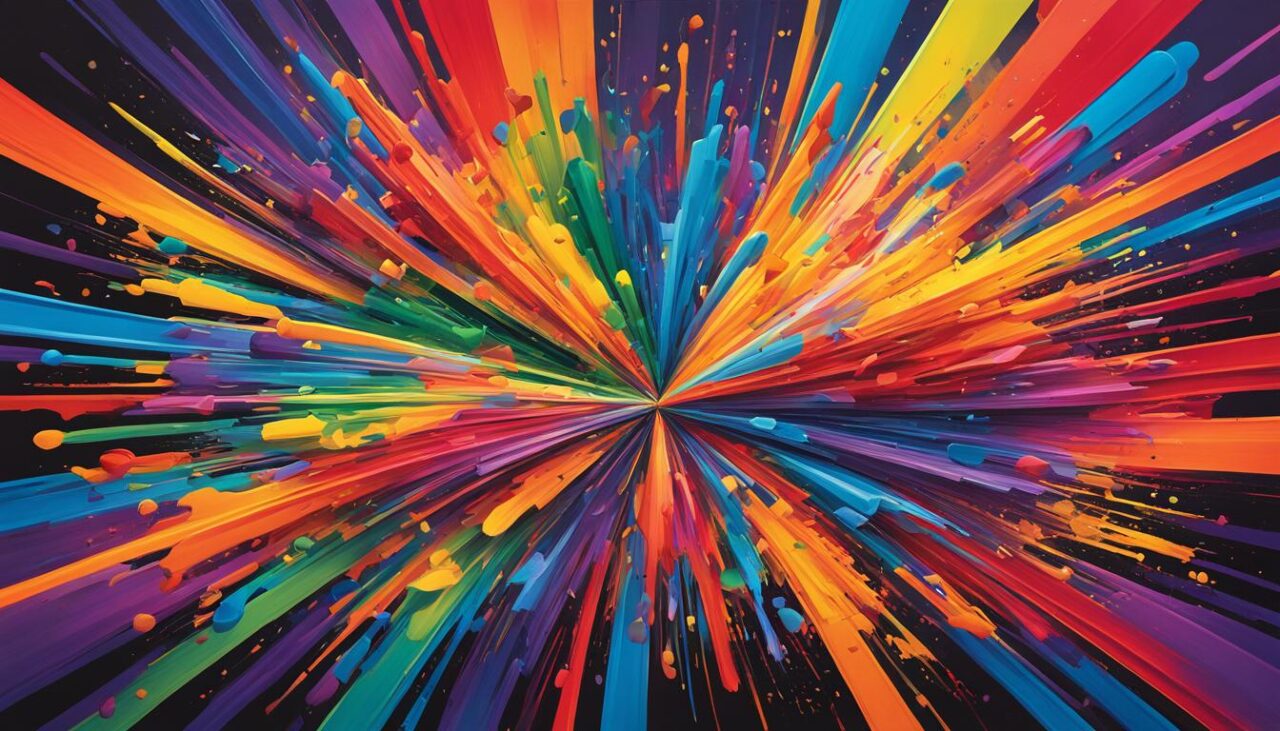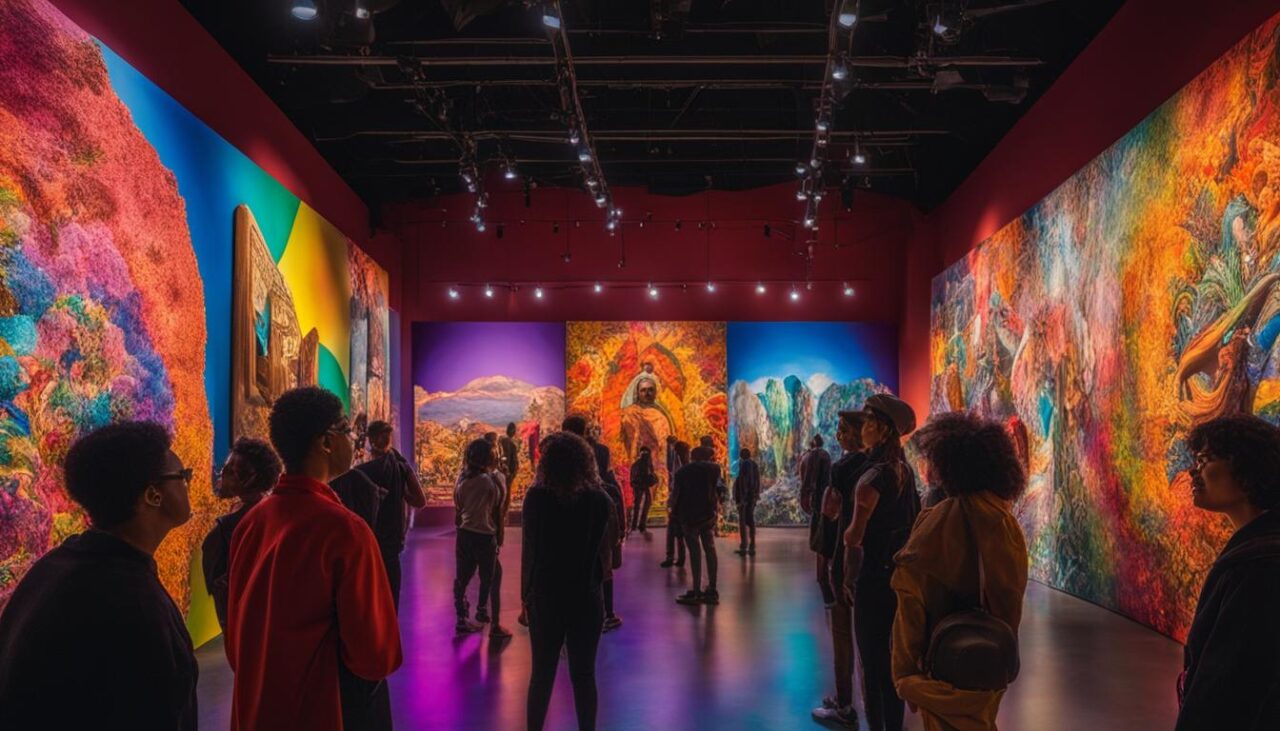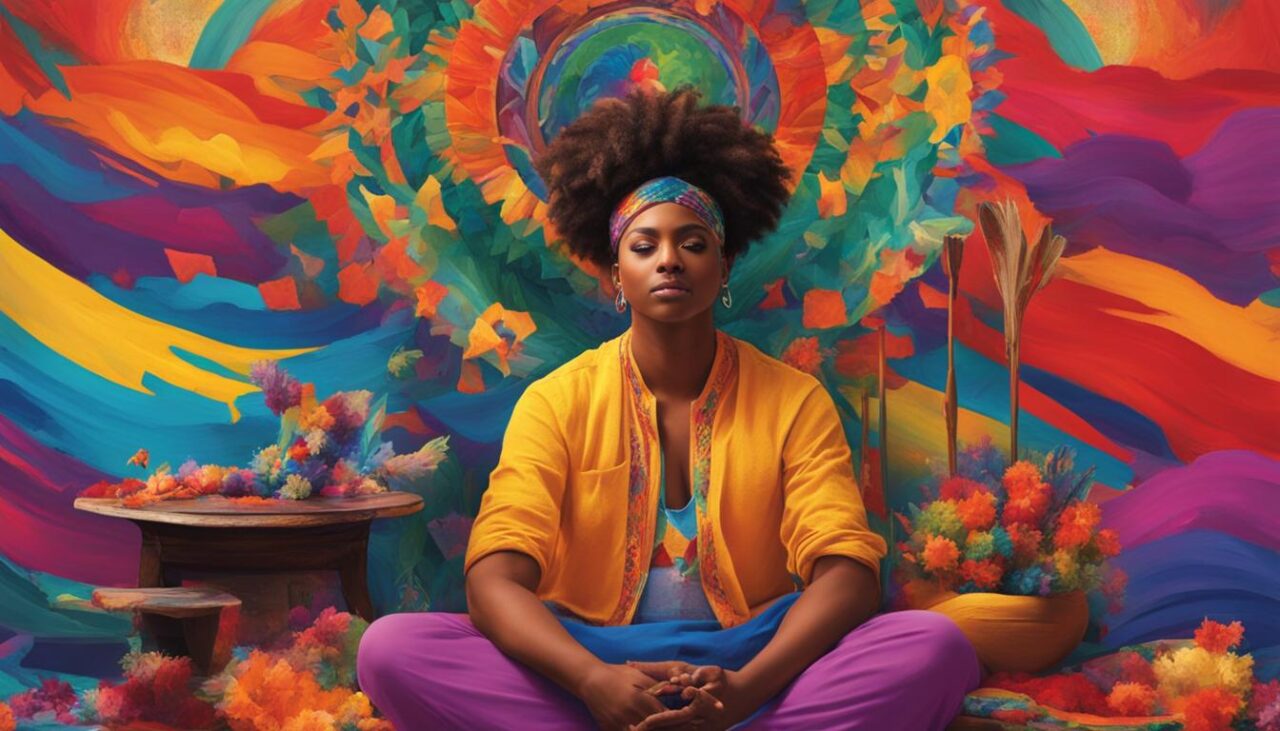LGBTQ visual art is a vibrant and captivating medium that showcases the diverse creative expressions of queer artists. These artworks tell visual narratives that push boundaries and challenge societal norms, highlighting the importance of artistic innovation in LGBTQ communities.
Through their works, queer artists bring to life the complexities of their experiences, sharing their stories with the world in visually stunning ways. These masterpieces of eye candy inspire us to think deeply about the world around us and encourage us to open our hearts and minds to the diverse perspectives of LGBTQ communities.
Join us as we explore the world of LGBTQ visual art and highlight the contributions of queer artists in promoting cultural dialogues and advancing artistic innovation.
Key Takeaways:
- LGBTQ visual art showcases diverse creative expressions of queer artists.
- Visual narratives push boundaries and challenge societal norms.
- Queer artists bring to life complexities of their experiences in visually stunning ways.
- LGBTQ visual art promotes cultural dialogues and advances artistic innovation.
- Masterpieces of eye candy inspire us to open our hearts and minds to diverse perspectives.
Exploring Contemporary LGBTQ Art and Queer Artists
Buckle up, because we're about to take a deep dive into the enchanting world of contemporary LGBTQ art and the bold, unapologetic queer artists who have revolutionized the art scene with their visual impact and artistic innovation.
One such artist is the legendary Keith Haring, whose vibrant murals and graffiti art captured the hearts of many. Haring's bold use of color, shape, and symbolism in his works made powerful political statements about the AIDS epidemic and LGBTQ visibility.

Another trailblazing queer artist is the visionary David Wojnarowicz, who deftly combined photography, painting, and mixed media in his works to explore themes of sexuality, mortality, and social justice. Wojnarowicz's visual impact can still be felt today in the contemporary art world.
Queer Artists Breaking Boundaries
“Art should be something that liberates your soul, provokes the imagination and encourages people to go further,” declared the enigmatic Larry Levan, the pioneering DJ whose iconic sets at the Paradise Garage nightclub in New York inspired many artists, including Keith Haring.
Today, queer artists like Mickalene Thomas, Juliana Huxtable, and Zanele Muholi continue to push boundaries with their works, challenging societal norms and uplifting marginalized voices. Through their visual impact, they are carving new paths for the LGBTQ community and all those seeking to express their true selves through art.
Innovative Art Forms
The world of contemporary LGBTQ art encompasses a vast array of innovative art forms, from digital art and video installations to performance art and public installations. One such groundbreaking artist is AA Bronson, who co-founded the queer artist collective General Idea in the 1970s, and went on to create works that defy categorization and elude definition.
Contemporary LGBTQ artists are using their art to communicate powerful messages, spark conversations, and foster cultural dialogues. By challenging traditional art forms and narratives, they are shaping the direction of art in the 21st century and beyond.
Art Exhibitions: Celebrating LGBTQ Creativity
Art exhibitions play a vital role in showcasing the creativity of LGBTQ artists and fostering cultural dialogues. These exhibitions create a safe space for queer artists to showcase their works and express themselves through their chosen mediums. Notable exhibitions such as the Queer Biennial and the Lesbians to Watch Out For exhibit provide a platform for LGBTQ artists to showcase their unique visual narratives and share their experiences with a wider audience.
Through these exhibitions, we can gain a deeper understanding and appreciation of the diverse and vibrant creative expressions of LGBTQ artists. The dialogue created during such presentations helps break down barriers and facilitates the sharing of experiences and perspectives across cultures and communities. It is through this dialogue that we can celebrate our shared humanity and learn to understand and respect life experiences that are different from our own.

“Art exhibitions provide a safe and inclusive space for queer artists to showcase their visual narratives and experiences. They foster cultural dialogues and break down barriers, helping us to gain a deeper understanding of diverse perspectives and celebrate our shared humanity.”
Bold Statements: LGBTQ Art and Activism
Art has always been a powerful tool for social change, and LGBTQ artists have used their talents to make bold statements and challenge societal norms. Through their visually stunning and emotionally impactful works, these artists have provoked important conversations and propelled the fight for LGBTQ rights forward.
The use of artistic innovation to convey meaningful messages is a hallmark of LGBTQ visual art. Queer artists harness their expressive mediums to create works that capture the attention and imagination of their audiences. From provocative street art to stunning photographic portraits, these works inspire and empower, encouraging viewers to see the world from a different perspective.
Perhaps most importantly, the bold statements made through LGBTQ art serve as a call to action. They demand change, using the power of visual narratives to create a sense of urgency around issues of discrimination, exclusion, and violence. As such, these artworks are an integral part of the fight for LGBTQ rights, and have played a critical role in driving social progress in recent years.
“The power of art to challenge and transform is undeniable. By creating works that challenge the status quo, LGBTQ artists are creating a world where all people are free to love, dream, and express themselves without fear of discrimination or marginalization.”
The bold statements made by LGBTQ artists have contributed to significant progress towards full LGBTQ equality. Through their works, these artists have helped create a more inclusive, diverse, and accepting society – one in which LGBTQ individuals can live freely and authentically.
The Intersection of Art and Activism
The intersection of art and activism has been a crucial driving force behind the LGBTQ rights movement. Throughout the decades, queer artists have used their talents to create works that shift cultural narratives, challenge societal norms, and advocate for LGBTQ equality. By using their expressive mediums to communicate important messages, these artists have secured a foothold in the collective imagination, giving voice to those who have been historically silenced and marginalized.
- LGBTQ visual art has made bold statements that have provoked important conversations and propelled the fight for LGBTQ rights forward.
- Queer artists harness the power of artistic innovation to capture the attention and imagination of their audiences and create works that inspire and empower.
- By making bold statements, LGBTQ visual art serves as a call to action, demanding change and driving social progress.
As such, the world of LGBTQ visual art is a vibrant and diverse one, characterized by a deep commitment to social justice and cultural transformation. It is a world in which bold statements are made every day, and where artistic innovation and activism come together to create a brighter, more inclusive future for all.
Art Therapy: Healing and Empowerment through LGBTQ Art
Art therapy is an integral part of LGBTQ visual art that offers a unique avenue for healing and empowerment. Through the use of expressive mediums, individuals within the community can explore and express their emotions, experiences, and identities in a safe and supportive environment.
The transformative power of art therapy lies in its ability to help individuals process and cope with personal challenges, such as trauma, anxiety, and depression, while also fostering self-acceptance and resilience. Artistic expression can provide a sense of control and agency over one's life, allowing individuals to gain a deeper understanding of themselves and their experiences.
For LGBTQ individuals, art therapy can also serve as a means of empowerment, allowing them to reclaim their narratives and challenge societal norms and stereotypes. Through their artistic creations, LGBTQ artists can inspire others, spark important conversations, and advocate for social change.
“Through my artwork, I strive to create a space for LGBTQ individuals to see themselves reflected and validated. Art therapy has been a powerful tool in this process, allowing me to explore and heal from my own experiences while also empowering others within the community.” – Jamie, LGBTQ artist and art therapist
Overall, art therapy offers a unique and valuable approach to healing and empowerment for LGBTQ individuals, highlighting the transformative and empowering nature of expressive mediums in the pursuit of personal growth and societal change.

Conclusion
LGBTQ visual art is more than just art, it's a form of cultural dialogue that promotes openness, acceptance, and equality. This art has the power to evoke emotions, challenge norms, and inspire change. The artistic innovation showcased by queer artists is a testament to their unique creative expressions and the diversity of the LGBTQ community.
It is crucial to recognize the significance of LGBTQ visual art in fostering cultural dialogues and promoting artistic innovation. The exhibitions celebrating LGBTQ creativity provide spaces for artists to be seen and heard, and provoke conversations that lead to societal change.
Art therapy serves as an essential tool in the healing and empowerment of individuals within the LGBTQ community. The expressive mediums used in LGBTQ art therapy facilitate transformation and promote self-discovery.
By recognizing and appreciating the vibrant and diverse creative expressions of LGBTQ artists, we can foster an inclusive society where everyone's voice is heard and appreciated. Let's celebrate LGBTQ visual art and continue the cultural dialogue it inspires.







